Billy Graham Center
Archives
Sawdust Trail Exhibit Items
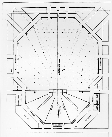 For most of his ministry, Sunday
had a special wooden tabernacle constructed for the meetings he held. At left is the blueprint
of the structure built for Sunday's Chicago campaign in 1918. Click on any of the following to
see exteriors and interiors of his tabernacles in:
For most of his ministry, Sunday
had a special wooden tabernacle constructed for the meetings he held. At left is the blueprint
of the structure built for Sunday's Chicago campaign in 1918. Click on any of the following to
see exteriors and interiors of his tabernacles in:
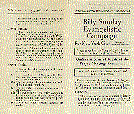 In addition to all the advance planning, counseling those who "hit the sawdust trail" after a Sunday meeting was also planned. The pamphlet shown to the right was prepared for the New York campaign in 1917 to outline how a prayer network would be developed to support the revival meetings. A similar publication was written to guide volunteer counselors who would talk with those who came forward, suggesting appropriate attitudes, points of emphasis and behavior. Click here to read a full-text transcript of the prayer pamphlet
In addition to all the advance planning, counseling those who "hit the sawdust trail" after a Sunday meeting was also planned. The pamphlet shown to the right was prepared for the New York campaign in 1917 to outline how a prayer network would be developed to support the revival meetings. A similar publication was written to guide volunteer counselors who would talk with those who came forward, suggesting appropriate attitudes, points of emphasis and behavior. Click here to read a full-text transcript of the prayer pamphlet
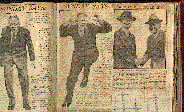
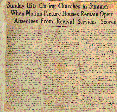
Scrapbook (left), compiled around 1921, of newspaper clippings, including columns
by Sunday such as "Sunday
Says"and 'Today's Best Story," but primarily of transcripts of Sunday's
sermons (right).
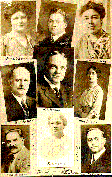 Billy Sunday during the height of his fame had about two dozen associates who helped
him organize and lead his city-wide meetings. Click here to view a
collection of photographs of a few of the following key members of Sunday's team.
His wife, Helen Sunday, served as general manager,
troubleshooter and protector. She had the final control of day-to-day operations, allowing
Sunday to concentrate solely on his preaching. Virginia Asher
did a number of things well, including singing, teaching Bible classes, and organizing
special meetings of businesswomen during the campaigns. B. D.
Ackley served as one of Sunday's pianists for the meetings.
Homer Rodeheaver played the trombone and led singing during the evangelistic
meetings; he also acted as announcer and master of ceremonies during the service and
prepared the crowd for Sunday's sermon.
Billy Sunday during the height of his fame had about two dozen associates who helped
him organize and lead his city-wide meetings. Click here to view a
collection of photographs of a few of the following key members of Sunday's team.
His wife, Helen Sunday, served as general manager,
troubleshooter and protector. She had the final control of day-to-day operations, allowing
Sunday to concentrate solely on his preaching. Virginia Asher
did a number of things well, including singing, teaching Bible classes, and organizing
special meetings of businesswomen during the campaigns. B. D.
Ackley served as one of Sunday's pianists for the meetings.
Homer Rodeheaver played the trombone and led singing during the evangelistic
meetings; he also acted as announcer and master of ceremonies during the service and
prepared the crowd for Sunday's sermon.
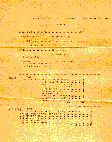 New converts were
not simply numbers to talley. Recordkeeping was nonetheless an important element of
Sunday's campaigns and instead ensured that the contact with an inquirer
or new believer was sustained. Reports and statistics were kept to create a trail by which
to maintain contact and evaluate the impact of the meetings.
Personal contact began at the evangelistic meeting: everyone who "hit the sawdust trail" shook Sunday's hand and then met with a counselor.
The counselor asked the inquirer his/her church preference and jotted down other basic
information on a standard card. They then talked about what it meant to give one's life to
Christ. The completed cards were later sent on to the local churches the inquirers had
indicated, so that the follow-up of young converts could continue. An example of the records kept is depicted in this
sheet of statistics, prepared for the board of elders of
Moody Church in Chicago, indicating the follow-up volunteers from the church had done
with inquirers who came forward during the 1918 Chicago meetings.
New converts were
not simply numbers to talley. Recordkeeping was nonetheless an important element of
Sunday's campaigns and instead ensured that the contact with an inquirer
or new believer was sustained. Reports and statistics were kept to create a trail by which
to maintain contact and evaluate the impact of the meetings.
Personal contact began at the evangelistic meeting: everyone who "hit the sawdust trail" shook Sunday's hand and then met with a counselor.
The counselor asked the inquirer his/her church preference and jotted down other basic
information on a standard card. They then talked about what it meant to give one's life to
Christ. The completed cards were later sent on to the local churches the inquirers had
indicated, so that the follow-up of young converts could continue. An example of the records kept is depicted in this
sheet of statistics, prepared for the board of elders of
Moody Church in Chicago, indicating the follow-up volunteers from the church had done
with inquirers who came forward during the 1918 Chicago meetings.
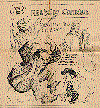
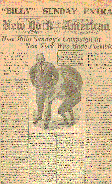 From about 1910 until 1920, Sunday was a national figure whose name was instantly
recognizable to the average person and who received voluminous coverage from
magazines and newspapers. These samples illustrate of favorable (left) and
negative (right) press coverage Sunday received. Sunday was a prime target for criticism.
Brann's Iconoclast (ca. 1918) was a newsletter printed in Chicago
which generally attacked the Prohibition movement and what it felt were examples of religious
intolerance. Mainstream newspapers often showed support by running special editions about Sunday
when he held a campaign in their city or printed "Billy Sunday Extras," like the one above put
out by the New York American during Sunday's 1917 meetings
in New York City.
From about 1910 until 1920, Sunday was a national figure whose name was instantly
recognizable to the average person and who received voluminous coverage from
magazines and newspapers. These samples illustrate of favorable (left) and
negative (right) press coverage Sunday received. Sunday was a prime target for criticism.
Brann's Iconoclast (ca. 1918) was a newsletter printed in Chicago
which generally attacked the Prohibition movement and what it felt were examples of religious
intolerance. Mainstream newspapers often showed support by running special editions about Sunday
when he held a campaign in their city or printed "Billy Sunday Extras," like the one above put
out by the New York American during Sunday's 1917 meetings
in New York City.
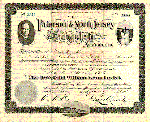 A committee of local pastors and businesspeople who had invited Sunday to their
city usually paid for and built the tabernacle. When the meetings were over, they
had it torn down and the lumber was sold to help meet outstanding expenses, if any.
Committees often issued a certificate to contributors,
such as this one from the Paterson & North Jersey Evangelistic Association at the time
of the 1915 campaign in Paterson, New Jersey.
A committee of local pastors and businesspeople who had invited Sunday to their
city usually paid for and built the tabernacle. When the meetings were over, they
had it torn down and the lumber was sold to help meet outstanding expenses, if any.
Committees often issued a certificate to contributors,
such as this one from the Paterson & North Jersey Evangelistic Association at the time
of the 1915 campaign in Paterson, New Jersey.
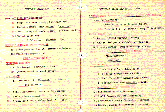 Typed copy of Sunday's notes for a sermon. The outline indicates the first line of his
sermon points and illustrations, based on Reveation 3:20, "Behold, I stand at the
door and knock. If anyone hears my voice and opens the door, I will come in to him
and dine with him, and he with Me." You can also hear an online audio file of Billy Sunday's "Booze" sermon at another Web site.
Typed copy of Sunday's notes for a sermon. The outline indicates the first line of his
sermon points and illustrations, based on Reveation 3:20, "Behold, I stand at the
door and knock. If anyone hears my voice and opens the door, I will come in to him
and dine with him, and he with Me." You can also hear an online audio file of Billy Sunday's "Booze" sermon at another Web site.
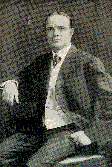
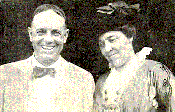
Although film footage of Sunday is extremely limited, many photographs of Sunday exist,
capturing his energetic preaching style, formal poses and down-to-earth ease. To see
a compilation of some of these, click here.
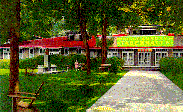 The
tabernacle pictured left was erected in Winona Lake, Indiana, the community Sunday
used as his home base of operations. The structure, named in Sunday's honor after his
death, no longer stands.
The
tabernacle pictured left was erected in Winona Lake, Indiana, the community Sunday
used as his home base of operations. The structure, named in Sunday's honor after his
death, no longer stands.
BGC Archives
500 College Ave., 3rd floor
Wheaton, IL 60187-5593
U.S.A.
Telephone: (630) 752-5910
E-mail: bgc.archives@wheaton.edu
Last Revised: 7/26/01
Expiration: indefinite
© Wheaton College 2005
 In addition to all the advance planning, counseling those who "hit the sawdust trail" after a Sunday meeting was also planned. The pamphlet shown to the right was prepared for the New York campaign in 1917 to outline how a prayer network would be developed to support the revival meetings. A similar publication was written to guide volunteer counselors who would talk with those who came forward, suggesting appropriate attitudes, points of emphasis and behavior. Click here to read a full-text transcript of the prayer pamphlet
In addition to all the advance planning, counseling those who "hit the sawdust trail" after a Sunday meeting was also planned. The pamphlet shown to the right was prepared for the New York campaign in 1917 to outline how a prayer network would be developed to support the revival meetings. A similar publication was written to guide volunteer counselors who would talk with those who came forward, suggesting appropriate attitudes, points of emphasis and behavior. Click here to read a full-text transcript of the prayer pamphlet For most of his ministry, Sunday
had a special wooden tabernacle constructed for the meetings he held. At left is the blueprint
of the structure built for Sunday's Chicago campaign in 1918. Click on any of the following to
see exteriors and interiors of his tabernacles in:
For most of his ministry, Sunday
had a special wooden tabernacle constructed for the meetings he held. At left is the blueprint
of the structure built for Sunday's Chicago campaign in 1918. Click on any of the following to
see exteriors and interiors of his tabernacles in:










